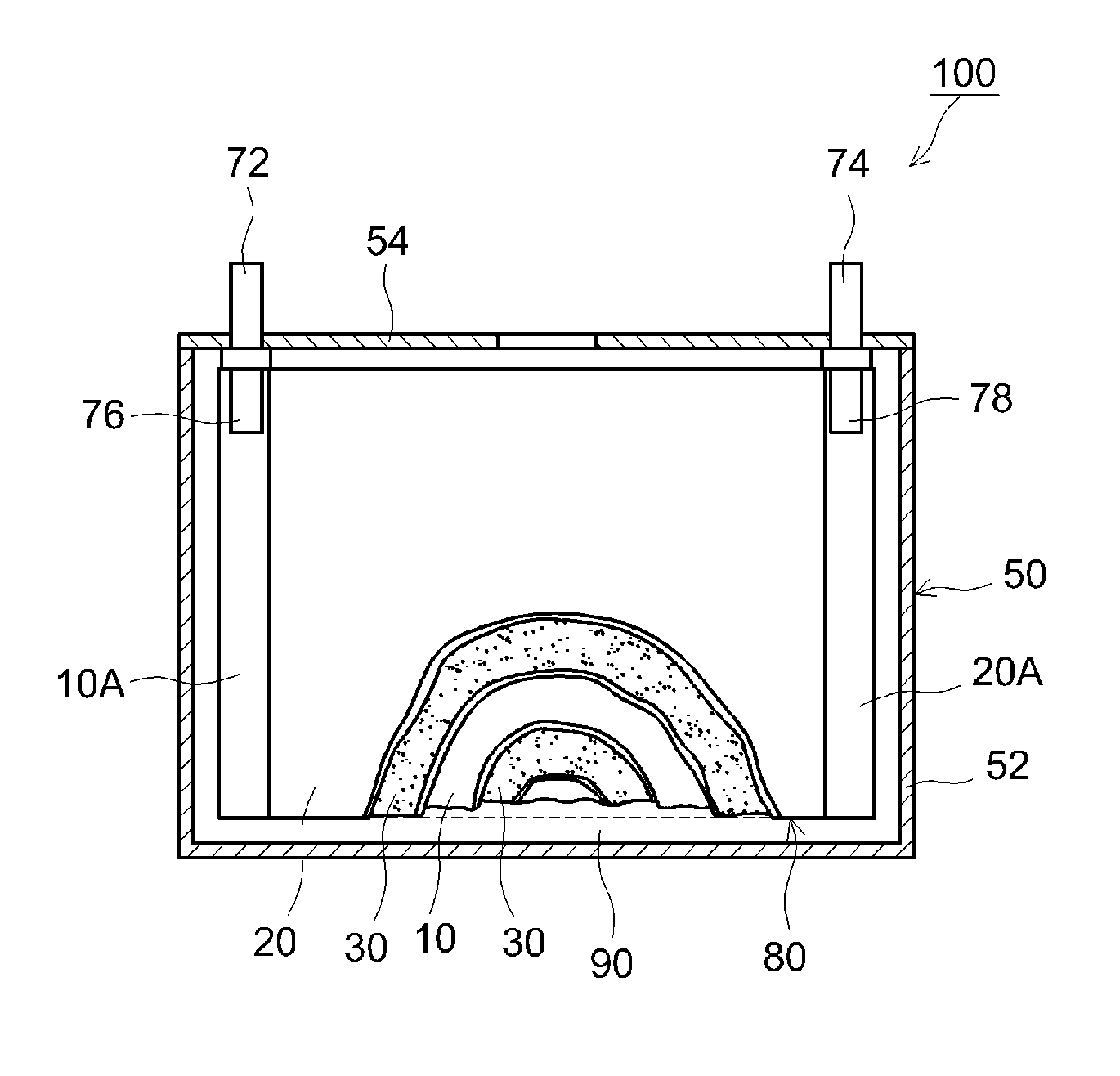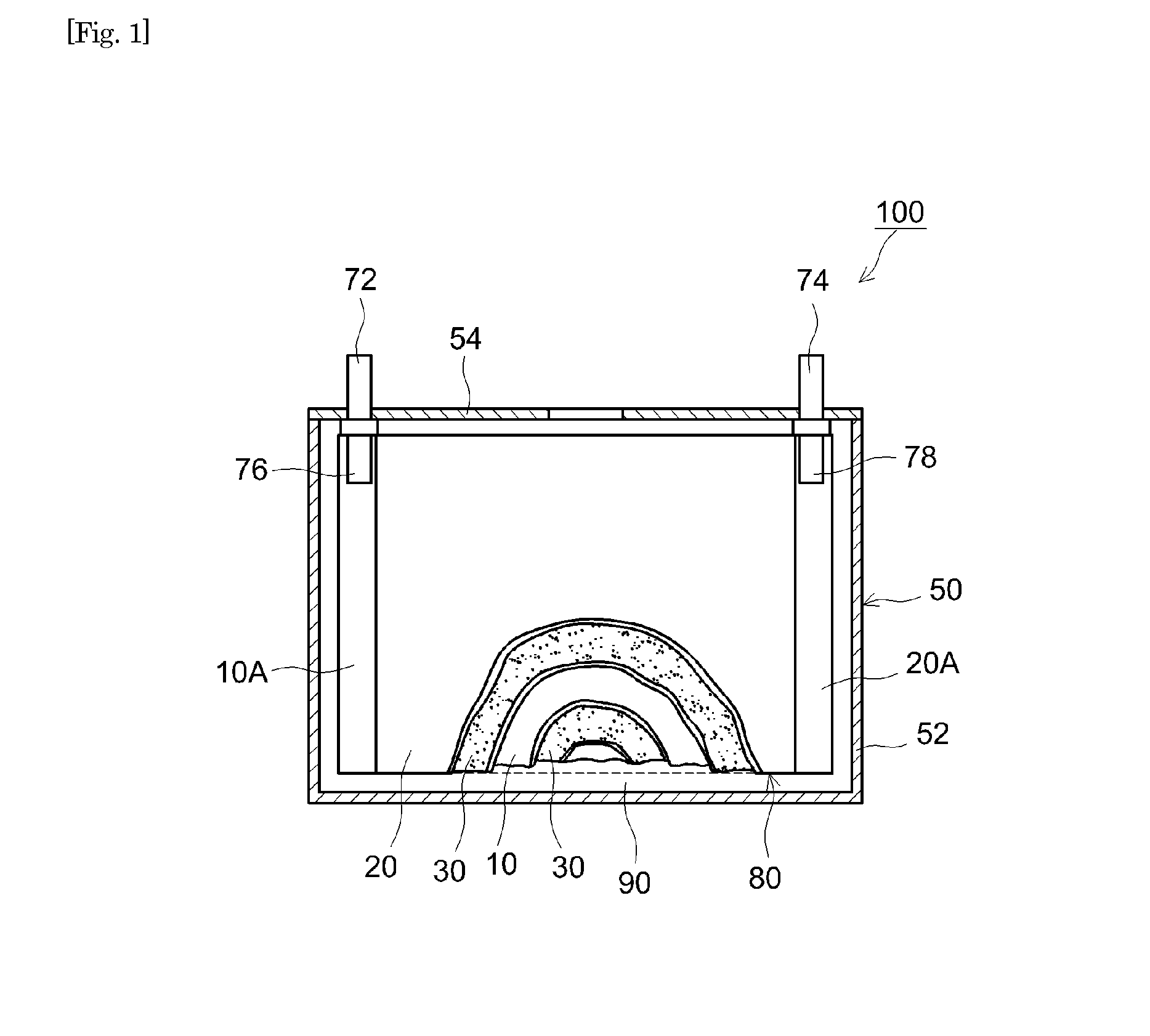Non-aqueous electrolyte secondary battery
a secondary battery and non-aqueous electrolyte technology, applied in the field of lithium secondary batteries, can solve the problems of increasing negative electrode resistance and reducing battery performance, and achieve the effect of reducing the negative electrode resistance and ensuring durability
- Summary
- Abstract
- Description
- Claims
- Application Information
AI Technical Summary
Benefits of technology
Problems solved by technology
Method used
Image
Examples
example 1
(Preparation of Positive Electrode Active Material)
[0130]In water, were dissolved nickel sulfate (NiSO4), cobalt sulfate (CoSO4), manganese sulfate (MnSO4) and zirconium sulfate at a Ni:Co:Mn molar ratio of 1:1:1 to a total concentration of Ni, Co, Mn and Zr of 1.8 mol / L to prepare an aqueous solution aqA. Ammonium paratungstate (5(NH4)2O·12 WO3) was dissolved in water to prepare an aqueous solution aqB (aqueous W solution) having a W concentration of 0.1 mol / L. To a reaction vessel equipped with a stirrer and nitrogen inlet, were added suitable amounts of 25% (by mass) aqueous sodium hydroxide solution and 25% (by mass) aqueous ammonia water to prepare a basic aqueous solution at pH 12.0 having a liquid-phase ammonia concentration of 20 g / L.
[0131]While the aqueous solution aqA, aqueous solution aqB, 25% aqueous sodium hydroxide solution and 25% aqueous ammonia water were supplied to the basic aqueous solution at constant rates to maintain the reaction mixture at or above pH 12.0 (s...
example 2
>
[0157]In this example, were used non-aqueous electrolyte solutions containing LiPF6 at about 1 mol / L concentration in a mixed solvent of EC, EMC and DMC at a 3:3:4 volume ratio and further containing LiBOB at concentrations (mol / kg) shown in Table 2. Otherwise, in the same manner as cells A1 to A9, battery cells B1 to B14 were constructed.
[0158]These battery cells were conditioned in the same manner as Example 1.
(Modification Treatment)
[0159]Each conditioned battery cell was subjected to a treatment to modify the OB layer formed by the conditioning. In particular, the respective battery cells were adjusted to 90% SOC and stored under the modification conditions shown in Table 2, respectively. For instance, with respect to battery cell B11, after adjusted to 90% SOC (battery voltage 3.97 V), the cell was stored in an environment at 75° C. for 35 hours.
(Negative Electrode Resistance Test)
[0160]With respect to each modified battery cell, the same Li precipitation test as Example 1 was...
example 3
[0175]In this example, was used a non-aqueous electrolyte solution containing LiPF6 at about 1 mol / L concentration in a mixed solvent of EC, EMC and DMC at a 3:3:4 volume ratio and further containing LiBOB at 0.025 mol / kg concentration. Otherwise, in the same manner as cells A1 to A9, battery cells C1 to C4 were constructed.
[0176]These battery cells were conditioned in the same manner as Example 1.
[0177]The respective conditioned battery cells were adjusted to 90% SOC (battery voltage 3.97 V) and stored under the modification conditions shown in Table 3, respectively.
(Evaluation of Amount of Mn Precipitation)
[0178]Each modified battery cell was discharged to 3 V and disassembled. With respect to a portion of the negative electrode sheet located at the outermost circumference of the wound electrode body, the negative electrode active material layer was subjected to ICP emission analysis to assess the amount of Mn present. Since the positive electrode active material was the only mate...
PUM
| Property | Measurement | Unit |
|---|---|---|
| voltage | aaaaa | aaaaa |
| temperature | aaaaa | aaaaa |
| open circuit voltage | aaaaa | aaaaa |
Abstract
Description
Claims
Application Information
 Login to View More
Login to View More - R&D
- Intellectual Property
- Life Sciences
- Materials
- Tech Scout
- Unparalleled Data Quality
- Higher Quality Content
- 60% Fewer Hallucinations
Browse by: Latest US Patents, China's latest patents, Technical Efficacy Thesaurus, Application Domain, Technology Topic, Popular Technical Reports.
© 2025 PatSnap. All rights reserved.Legal|Privacy policy|Modern Slavery Act Transparency Statement|Sitemap|About US| Contact US: help@patsnap.com



